While powdery mildews don’t kill their hosts, they sure do a number on them. And that is particularly true for powdery mildew of apples and crabapples, caused by Podosphaera leucotricha.
This pathogen attacks both cultivated and wild apples and crabapples. And it occurs in the all regions of the world that produce apples!
Powdery mildews get their name from the white spores that are produced by the mycelia (fungal threads). The disease on apples attacks virtually every stage of the plant – buds, blossoms, new shoots, leaves, and fruit.
The disease can be severe enough that no fruit form.
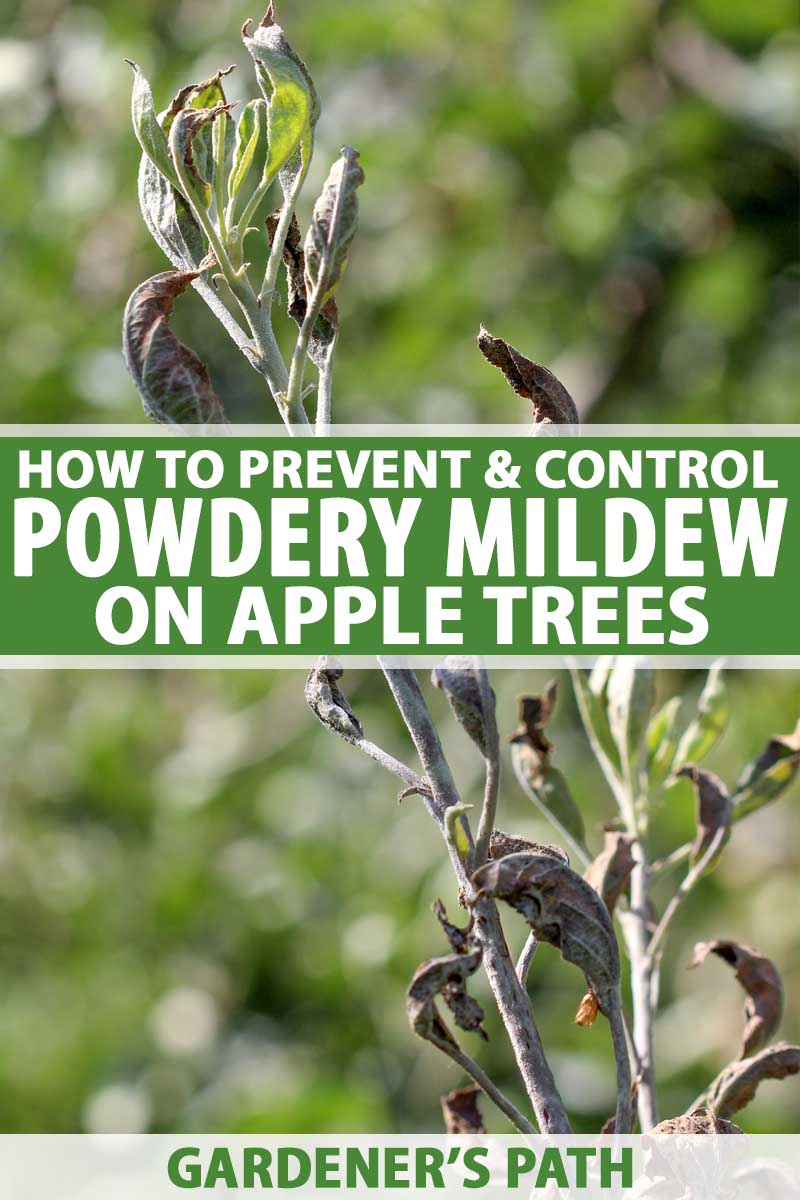
We link to vendors to help you find relevant products. If you buy from one of our links, we may earn a commission.
While fungicides are the standard treatments, there are some cultural practices that can help control this disease as well.
Unlike most fungal infections, apple powdery mildew spores do not require moisture to germinate. Therefore, this infection is known as the “dry weather disease.”
Read on as we walk you through the steps you take to diagnose and treat powdery mildew infection on your apple or crabapple tree.
What You’ll Learn
Symptoms of Primary Infections
If your tree is infected, the first thing you will notice is a delay of up to four days in the opening of the infected buds in the spring. These buds are covered with spores.
Next, the leaves and blossoms become covered with the fungal spores as they emerge from their buds. The spores look like a light gray or white powder, and the infected leaves curl upward.
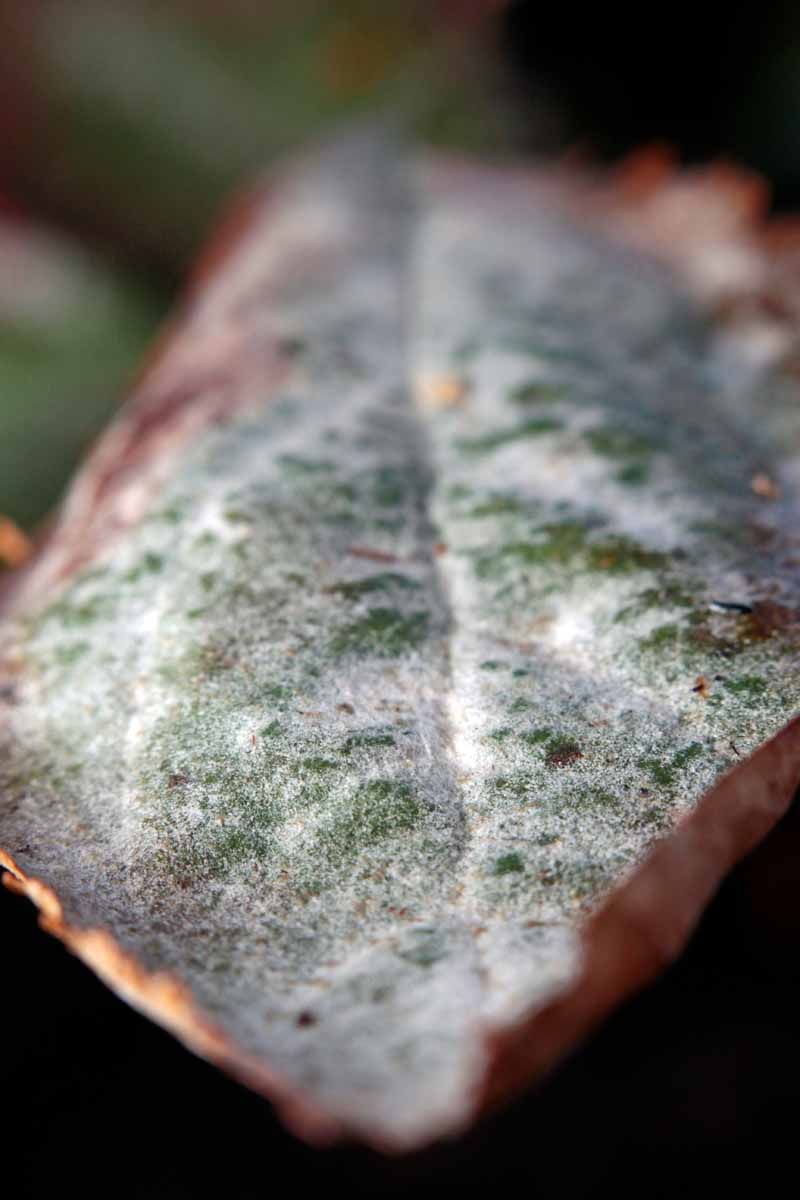
Both sides of the leaves and tree shoots will be covered with this powder.
The flowers develop abnormally, are usually greenish-white, and don’t produce fruit.
An Infection That Won’t Stop
These spores are easily blown by the wind and cause secondary infections on new shoots, leaves, and fruit.
As long as the shoots continue growing, the leaves and shoots can continue to become infected.
The infections typically occur at night at 65 to 80°F when the relative humidity is greater than 70 percent. While this sounds really high, it is common on the lower leaf surface.

The disease on the leaves occurs first on the undersides and may appear like chlorotic spots on the top of the leaves.
As time passes, the tissues that are infected develop the classic silver-gray powdery mildew appearance.
Fruit that is infected will come down with discoloration and netlike reddish brown colors. It may also be distorted and/or dwarfed.
High levels of powdery mildew at the end of the growing season can damage the tree in two ways. First, it can increase the number of infected buds, so you will have a high level of infection next spring. And second, it can inhibit the formation of flower buds, so that there will be fewer or no fruit produced the following season.
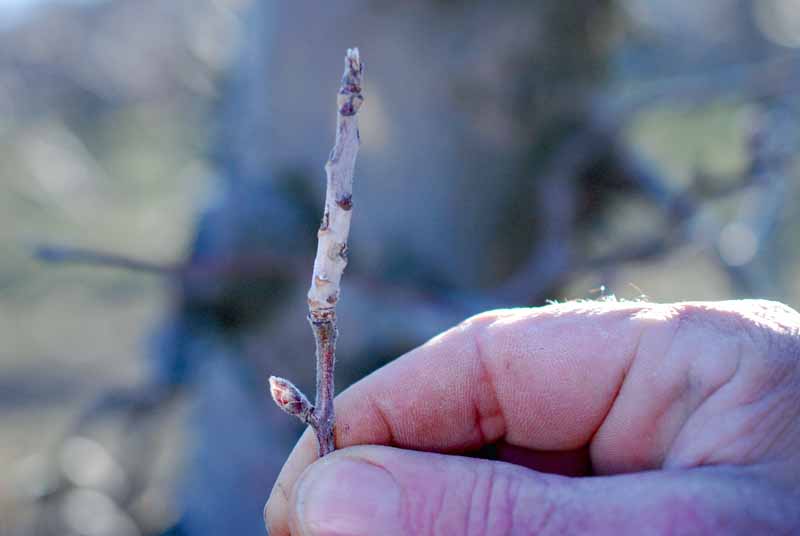
And if that isn’t bad enough, a tree that is heavily infected with powdery mildew can become susceptible to additional types of infections.
Cultural Controls
You should prune any shoots that appear white in the early spring, so they won’t spread spores.
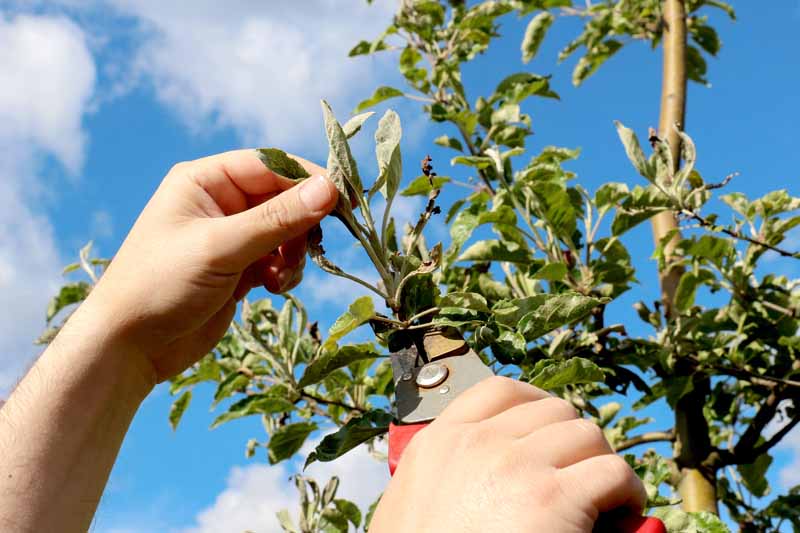
Avoid the excessive use of fertilizer, especially in the late summer. This will prevent succulent new tissue from growing, which is easily infected by the fungus.
Another thing you can do to protect your tree is to plant it in a sunny area, since excessive shade, high humidity, and poor circulation all increase the chances of infection.
Fungicides
Since this is such a difficult disease to control, and it is critical to eliminate the spores that will keep reinfecting your tree, you may choose to apply fungicides. Be sure and choose ones that are labeled specifically for fruit trees.
You have a choice of low toxicity fungicides like horticultural oils. These include jojoba oil, neem oil, and brand name spray oils designed for fruit trees.
You can find AzaGuard Neem Oil available from Arbico Organics in 32-ounce or one-gallon bottles.
Classic fungicides that are used against apple scab, such as sterol inhibitors, are highly effective at controlling powdery mildew. These include myclobutanil and fenbuconazole.
Another option is potassium bicarbonate which kills spores on contact, available as MilStop via Arbico Organics.
MilStop is listed by the Organic Materials Review Institute (OMRI) as approved for organic gardens.
Since the fungus overwinters inside buds, you should start treating your tree early in the season before the blossoms start to show a pinkish color.
The failure to spray before the blooms opens is one of the most common mistakes made in controlling this disease according to the American Phytopathological Society.
Be sure and repeat the sprays at two to three week intervals until the new shoots stop growing. That could mean as many as 18 sprays if your cultivar is highly susceptible!
Also be sure to continue spraying even if the weather becomes dry. Unlike most other foliar pathogens, apple powdery mildew continues its growth and spore production in dry weather.
Prevention
You can also spray sulfur fungicides before the symptoms appear.
Be careful with sulfur. You can harm the plant if you apply it within two weeks of a chemical fungicide or if the temperatures are greater than 90°F.
Bonide has sulfur plant fungicide available in one-pound bottles or four-pound bags available from Arbico Organics.
This class of fungicides includes the classic Bordeaux mixture of copper sulfate and lime. This combination is highly effective at preventing powdery mildew and is certified organic. You can buy a pre-packaged mixture designed for small gardens.
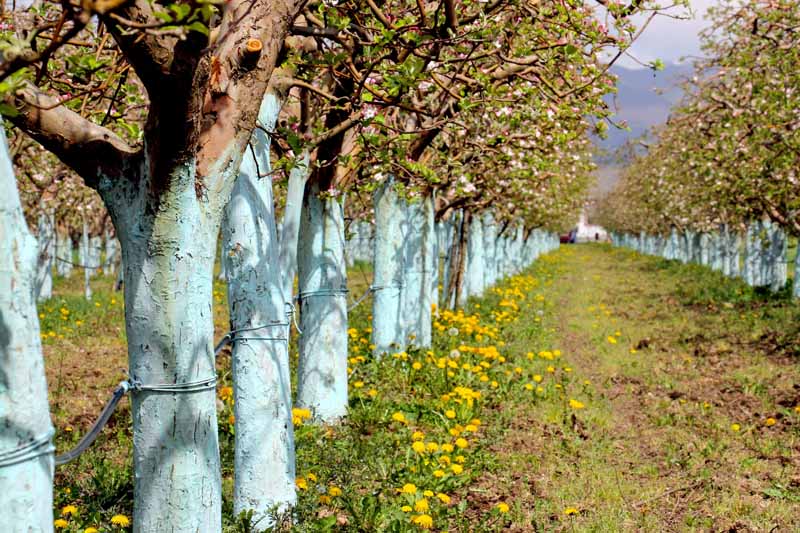
The ultimate prevention technique is to plant resistant varieties! Some of the most popular cultivars are the most susceptible – Granny Smith, Jonathan, and Rome for example.
Some of the more common resistant cultivars include:
- Braeburn
- Britegold
- Delicious
- Enterprise
- Fuji
- Gala
- Jonafree
- Nittany
- Winesap
Apple Crop Risk
Although apple powdery mildew will not technically kill your crop, it can debilitate the tree to such an extent that it could be unable to produce any fruit.
This disease is widespread on wild and cultivated apples and crabapples in every part of the world in which they are grown.
Therefore, it is critical to know the symptoms of this mildew, so you can be ready to take action as soon as you see infected tissue.
You will need to spray with some sort of fungicide – sulfur, horticultural oils, or sterol inhibiting fungicides. A strict spray schedule may help save your tree from this aggressive pathogen.
Have you successfully fought off powdery mildew on your apple or crabapple tree? Let us know how your battle went in the comments.
And if you’re still trying to identify a specific disease on your apple tree(s), then some of these guides may be of assistance:
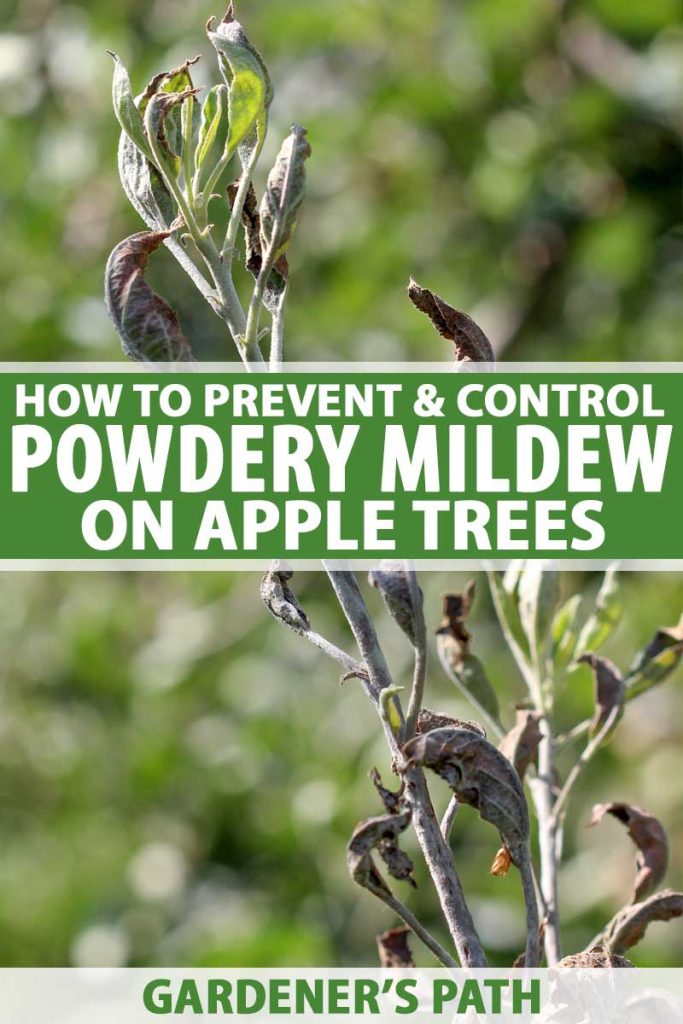
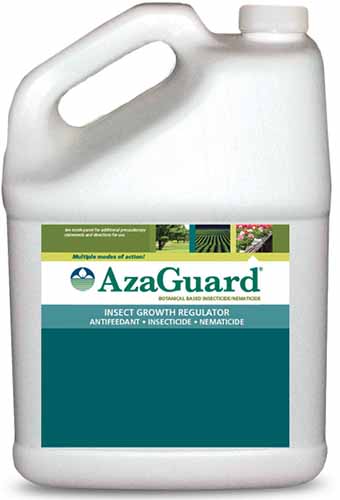
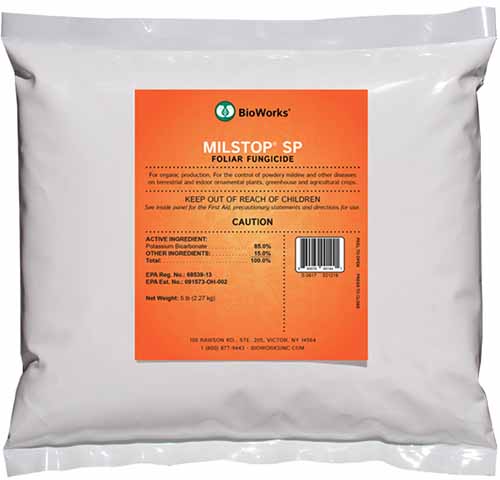
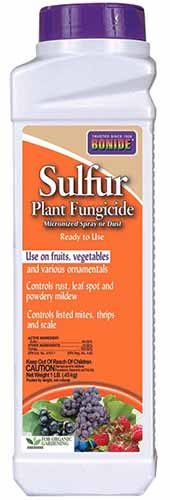
Seems my tree has this, it’s approx 5 year old, I’m unsure of the variety, aldi bought. I’m going to see I can create a natural fungicide to tree with. I’m going to prune the end of September and I will give the first treatment then. In spring when it starts budding, I will start treatment again. Hopefully it works, I will try a different method in the next year if the natural one fails.
Hi Jaye, I’m sorry that your apple tree is infected! Have you considered treating it with neem oil? That is all natural and often really effective.
Hi,
I saw that you posted this just 16 hours ago.
I’m presently treating my one apple tree with neem oil.
You say this works?
Just spay-mist it, even the top branches?
any advice?
Thanks;
Dave
Hi Dave, I don’t have fruit trees myself, but neem oil comes highly recommended. You are definitely on the right track. Spray mist it. It’s important to cover the whole tree to kill the pathogen, so you should definitely be spraying the top branches. Try to spray the tops and bottoms of the leaves, so you will kill all of the fungi. Let us know how it worked if you have time!
My dwarf apple tree… The lower leaves I’ve noticed have a tiny pattern of white spots. It’s not powder, it’s in the leaf.
Thank you for posting a picture of the leaves! I’m so sorry that your apple tree has this problem. You are definitely right that it is not powdery mildew. I can’t be positive, but it looks like insect damage to me. However, I am not positive and cannot suggest a particular pest that would cause those symptoms. I would recommend that you submit a sample to your county extension person. Here is the link to figure out the right office to contact. And if you do find out, please let us know. I am highly curious about what the culprit… Read more »
Hi Helga, I just saw my apple tree leaves and little fruits have the white fungus today. The leaves and little apples look dred out and not healthy. How can I use the neem oil? Do I have to mix it with water? How much water and oil? Please let me know ASAO, so I can start tomorrow to spray it. Tomorrow will be raining. Is it okay to spray? I cut up lots of curly leaves today. Some little fruits are still good. It is a 4-variety apple tree in the pot. I have had it for 10 years.… Read more »
Hi MLT, I’m sorry to hear that your apple tree is infected with powdery mildew. Fortunately, it is one of those fungi that doesn’t kill their hosts. I admire your zeal, but I think it would be best to wait until the rain has stopped. It would be likely to wash the neem oil off the tree. I don’t have a label with me, but it should give clear instructions. I am pretty sure that you spray the neem oil directly from the bottle. The manufacturer will already have diluted it to an appropriate concentration. The tips I do have… Read more »
Hi, same problem with my apple tree. I cut away loads of leaves, looks like I have to denude the tree to remove all the mildew. Could I avoid this by just using neem oil? Thanking you in advance. I live in Ireland.
Hi Ann, I’m so sorry that your apple tree has such a severe case of powdery mildew. Neem is often used to treat powdery mildew. I can’t guarantee that it will work for you, though. Definitely spray both the top and bottoms of the leaves. Another option that is organic is Bordeaux mixture. It’s a mixture of copper and sulfur. Since you are in Ireland, I’m not sure of the brand names of the fungicides that I would recommend. There is a class of fungicides called sterol inhibitors that can be very effective. Two of them are myclobutanil and fenbuconazole.… Read more »
Thank you so much. Garden centres opening on Monday, after lockdown. Take care.
I’m just in from cutting more leaves off the tree. Should I be gowned up like for corona? We are all so stressed now ????????
Hi Ann, Again, I’m so sorry about your tree. Yes, these are stressful times. However, one good thing is that you do not have to worry about being gowned up while you prune your tree. Most plant diseases do not affect humans, and this is absolutely the case for powdery mildew. It is highly advanced at closely interacting with the plant. It is absolutely not a threat to you. Best of luck at the gardening centers!
Thank you so much Helga, have a lovely Sunday
Hi,
My apple tree has same problem White powdery fungus, I am so upset for my tree. I cant go outside in my garden bcoz of hayfever, Please guide me
Hi Aroush, I’m so sorry about your apple tree. That is a distressing infection. If your tree hasn’t bloomed yet, you should cut off the infested twigs (when you can go out into the garden again). You will need to treat your tree with a fungicide like neem oil or one of the other ones described in the article. I hope that you will be able to cure your tree!
Hi Helga… please can you help? My little apple is showing signs of mildew. If I spray with neem oil, will it affect the fruit in any way?
Hi Sophia, I’m sorry your apple tree has powdery mildew. Neem oil should be perfectly safe to use and shouldn’t affect the flowers at all. Good luck!
I just identified that my orchard of 240 apple trees has Powdery Mildew. Many of the trees have fruit on them and the fruit looks okay. Every tree however has the mildew. Many of the new shoots from this season seem to be dead or dying even though there is still good growth and the trees over all look okay. The question I have is, what should I do now? It is early June and the weather is in the 80-90s and will soon be consitently in the 90s. We are in the drier part of Idaho. What treatment should… Read more »
Hi Ammon, I am so sorry that your whole orchard is infected with powdery mildew! I’m glad that the fruit look okay. Most of my advice is geared for homeowners, so I did some research with information for apple orchards from the University of Idaho. You can prune out the infected shoots, which won’t necessarily work, and doesn’t sound feasible for so many trees. I think your best bet is treatment with fungicides. Page 8 of the PDF recommends a series of sterol inhibitors, sulfur, and Sovran or Flint to treat powdery mildew. I hope this provides enough detail to… Read more »
I have a rose bush with powdery mildew about eight feet away from two paradise apple trees. Is there any chance the rose bush mildew will infect my apple trees? Thank you.
Unfortunately this disease can spread easily in ideal conditions, especially if left untreated. See our article on rose diseases for more info.
Hi Jeff,
While it’s true that powdery mildew spreads very rapidly, the fungi are very specific for their hosts. I think it’s highly unlikely that the powdery mildew from your rose would infect your apple tree.
Hello, my apple tree is 2 years old and started showing signs of powdery mildew a few months ago. I didn’t realize it until a month ago and started spraying with neem. It doesn’t have any flowers or buds yet, just leaves. Should I just spray it, or should I pick off infested leaves and trim the stem/super baby trunk down below where I can see the mildew starts? I’m not sure how much would be too aggressive for such a young tree. Thank you!
Hi Melissa, I’m sorry that your apple tree is infected with powdery mildew. You should definitely remove the infested leaves, so they won’t spread the spores. Spraying with neem oil is an excellent idea, too. It is usually effective against this fungus. You will need to keep spraying every 2-3 weeks until the new shoots start growing. Don’t stop if the weather dries up, because this pathogen will keep growing. I don’t think you need to trim the stem down. Hopefully that combination of actions will help stop the infection. Let us know how it goes.
Hi, My 11-year-old daughter planted an apple seed as an experiment during lockdown, and it is doing really well. Started to notice this powdery stuff on the leaves… how can I treat this please? It’s approx. 2-3 months old and has been kept in the house. Regards
Hi Ailwyn,
What a wonderful experiment! That is great that it was doing so well.
Thank you for providing a picture! I’m sorry about the powdery mildew. There are various fungicides you could apply, but since it’s in the house and being tended by a child, I would suggest something with really low toxicity. I think neem oil would be a good choice. Be sure to spray the tops and bottoms of the leaves. That should bring it back to health. I hope it grows into an awesome tree!
Hi Helga, Thank you for this great article. My two apple trees have powdery mildew. I have 4 questions. 1) If all the leaves appear to have the mildew, will it be okay for me to remove all of the leaves, so that only bare stems are left? 2) Should I spray the neem oil all over the branches, stems and open cuts where I’ve trimmed the trees down for autumn? 3) The article says copper sulfate and lime works to ‘prevent’ powdery mildew. Would it still help to apply even though I already have powdery mildew? And should I… Read more »
Hi Rachel, Thank you so much for your kind words! We are delighted that you liked the article. 1) Yes. You should remove all of the leaves if they have powdery mildew, or they will continue spreading the disease. 2) Yes. You should spray all parts of the tree with neem oil, since the fungus can infect the whole tree. 3) I don’t think it would help to use copper sulfate and lime at this point. I suggest that you just stick with the neem oil. 4) You can use 70% rubbing alcohol. A lot of people use 10% bleach,… Read more »
Thank you so so much for your great reply. V much appreciate it. Have a lovely evening. Rachel
Hi Rachel,
Thank you so much for taking the time to comment! We greatly appreciate it.